Green Tara guided meditation video, guided by H.E. Zasep Rinpoche with beautiful Tara images and animations; finishing with magnificent Tara mantra chanted by Yoko Dharma
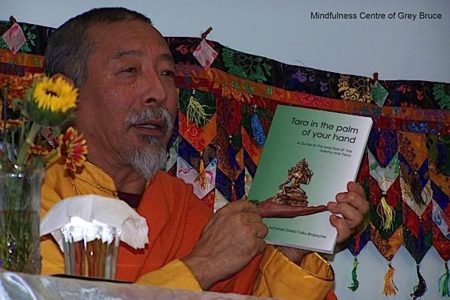
Green Tara is almost certainly one of the most popular Englightened Buddhas in Vajrayana Buddhism. Tara’s mantra is chanted daily by many Buddhists around the world. Tara — the Liberator, the saviour, the healer — is the “Mother of all Buddhas. Please enjoy and benefit from this guided meditation video on Green Tara practice for both uninitiated and initiated practitioners, with animated visualizations of the Tam syllable, green light and Green Tara, by H.E. Zasep Rinpoche, author of Tara in the palm of your hand — the authoritative English commentary on Surya Gupta 21 Taras>>
Relax, sit straight, half close your eyes, and listen to H.E. Venerable Zasep Rinpoche guide you through visualizing Tara and chanting her mantra. Then, chant along with Yoko Dharma’s amazing voice at the end of the meditation — with yet more beautiful meditational images.
[Full transcript of the teaching below the video.] Venerable Zasep Tulku Rinpoche has taught in the West for 40 years and is spiritual head of Gaden for the West centres in Canada, U.S. and Australia.
Full 25 minute guided visualization and mantra chanting, with animated visualizations and images:
View more teaching videos (and please subscribe) on our YouTube Channel>>
Transcript of teaching
Today I’m speaking about Tara practice visualization, healing practice, and recitation of the mantra of Tara. Tara is the liberator. Tara means, Tibetan word is Drolma. So there’s a different ways of practicing Tara Sadhana.
Those of you have not received Tara initiation, you can visualize Tara in front of you, and then visualize Seed syllables, mantras, and lights, and you recite the mantra of Tara for the purpose of receiving blessings, and inspirations, and healing, and then, at the end, Tara dissolving into you.
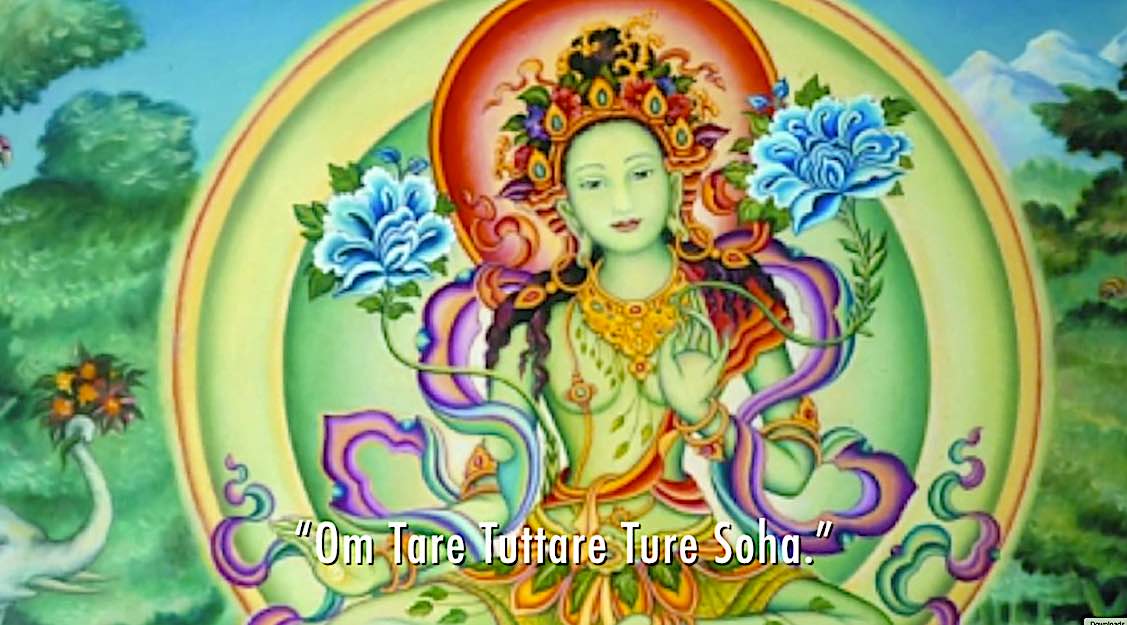
Those of you have received Tara initiations, then you can visualize yourselves as a Tara.
I will explain Tara visualization and practice for those of you have not received Tara initiations.
So you first sit on a meditation cushion comfortably, relax your body, and try to have a calm abiding mind. If your mind is not very calm, and if your mind is not settled, then you could do mindfulness of breathing meditation for five minutes. Breathe in and breathe out, breathe in slowly for long one, breath out slowly, a long one. This way it will relax your body and mind.
Then, you visualize Tara in front of you, not too high, not too low, about the same level as your forehead, about five feet in front of you, and imagine a beautiful blue sky. In this sky you imagine, instantly, a green Tam syllable appeared. T-A-M, English letter, T-A-M you visualize. If you know how to visualize Tibetan syllable Tam, green one, that would be good, otherwise the English letter is fine. Visualize Tam syllable, green one, and a very beautiful Tam syllable with a nature of light and energy.
And then, after you visualize this tam syllable, and then imagine beautiful green light emanating from the Tam syllable. Then gradually, the Tam syllable transform into Green Tara.
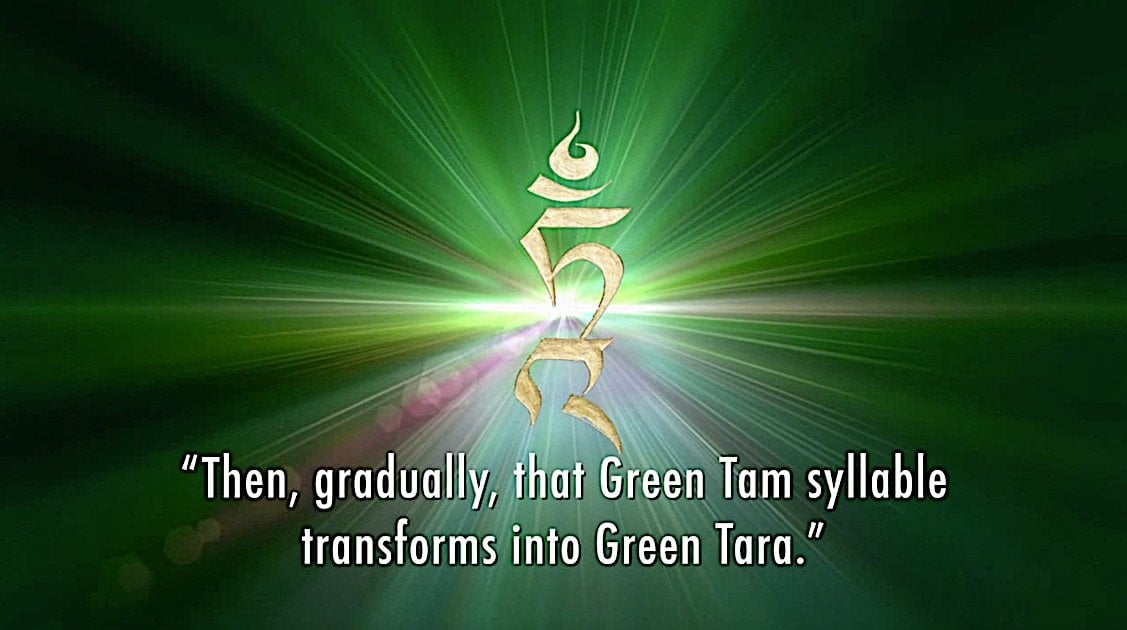
So now you have a Green Tara appeared, and she is sitting on the lotus and moon cushion, a beautiful lotus cushion. In other words, the cushion is made with lotus petals. Pink and white petals. And on the top of this lotus cushion, you visualize white moon disc horizontal. Then on top of this moon disc, visualize a green Tam letter again. A beautiful green Tam letter appeared spontaneously, you visualize.
And then light emanating from that green Tam syllable, more light emanating, and then instantly Tara herself appeared. And she had a beautiful green color like the color of emerald, precious stone. And she has one face, two hands, she’s sitting on the lotus and moon cushion. Her right foot is stretched, and left foot is bent, and in her hands she’s holding blue utpala flowers. Right hand is on the top of the right knee holding blue utpala flower with the petals open, and she’s holding the trunk of the utpala flower. Left hand she’s holding also the trunk of the utpala flower, and the petals open on your left side of the shoulder. And her fingers in the mudra representing the left hand is in the mudra of representing Buddhas of the three times. What that means is that Tara herself, embodiment of the Buddhas of the past, present, and future. So here’s three fingers up, that symbolizes she herself representing the three Buddhas of the three times.
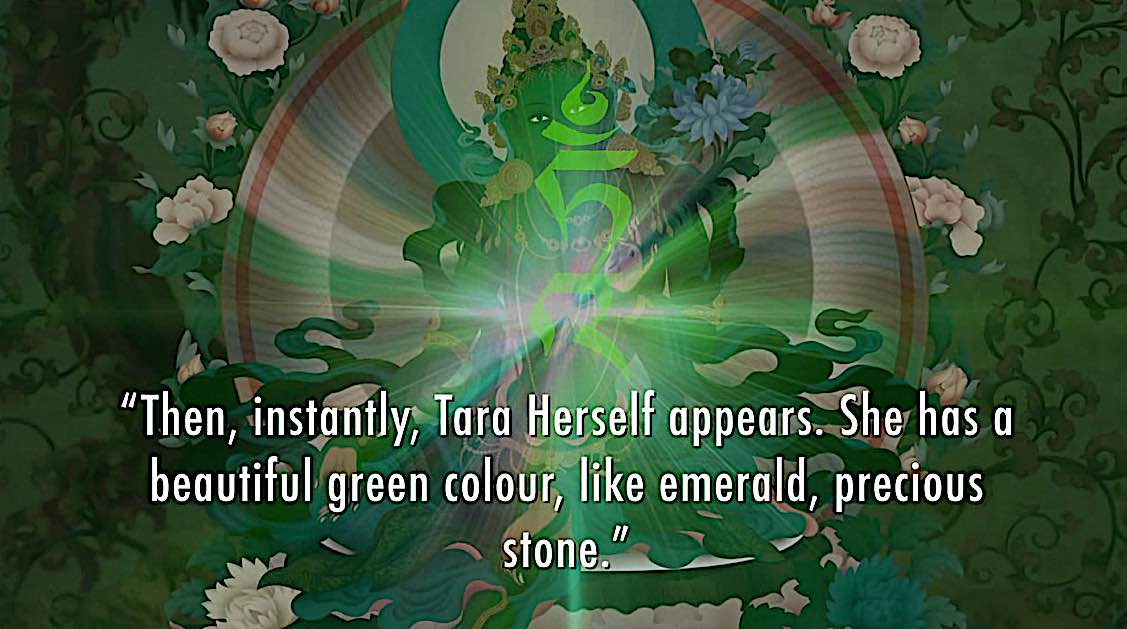
And then her thumb is meeting with the ring finger. This is symbol of meeting … How should you say … Meeting or merging of the two truths. Ultimate truth — and conventional truth. And also this symbolize love and compassion, and so forth. So there’s different ways of interpreting these mudras. They’re not always fixed, there different ways you can explain.
Her right hand is in a mudra of giving blessings, and giving realizations. She’s wearing beautiful silk dresses, upper garments and lower garments. She’s wearing her beautiful jewel ornaments, crown ornament, earrings, and necklaces, and bracelets, and so forth. She has long hair with a top knot, rest of hair hanging loose behind her body.
And also when you visualize, you imagine the deities divine body is always pure, always perfect, and transparent. A nature of clear light and bliss, and not solid material body.
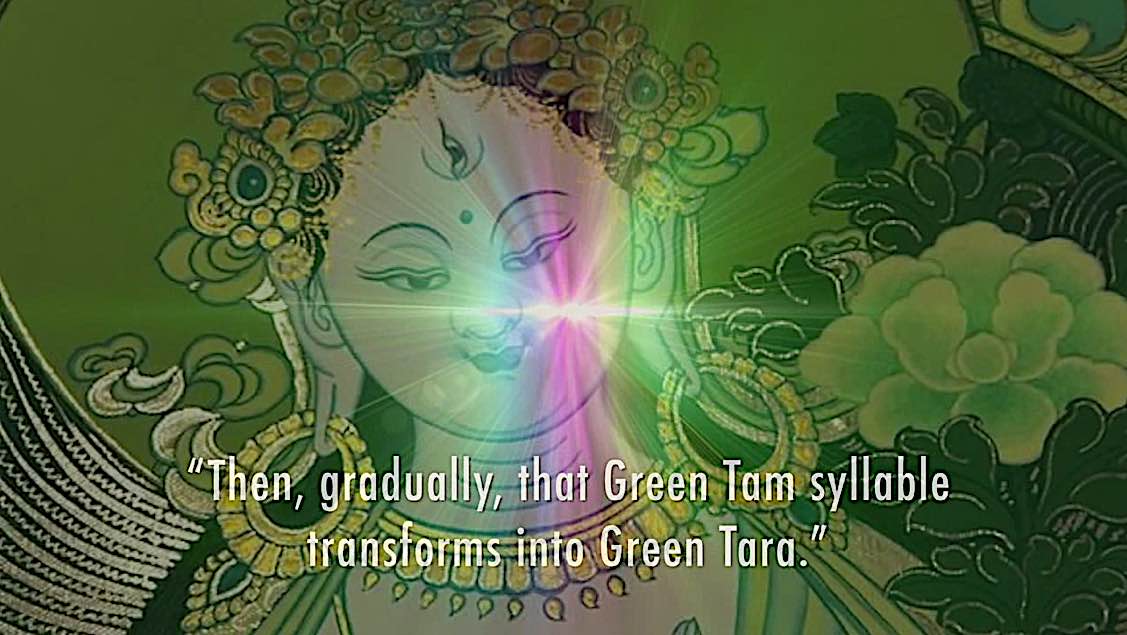
So now you visualize Tara in front of you. Then you visualize a small moon disc at Tara’s heart. In the middle of the moon disc you visualize Tam syllable standing upright at her heart. Now when I say her heart, means actually right in the middle of her chest between the two breasts. In middle, small moon disc.
Then visualize green Tam syllable standing upright. And this green tam syllable is surrounded by ten syllable Tara mantra, Om Tā re Tu ttā re Tu re Svā hā, ten syllables. These ten syllables standing clockwise, not counter clockwise. Some people think well it should be counterclockwise because it’s mother tantra, so forth. No, according to Tara teaching, it said that it should be clockwise.
The mantra is also green. And there also nature of light and energy, and also each syllable’s producing the sound of each syllable or the sound of the mantra producing self-sounding, Om Tā re Tu ttā re Tu re Svā hā. Self-sounding. Maybe you can hear the sound. This is a Holy sound, and divine sound of Tara mantra.
So now, it’s lot for some people who are new with Tibetan Buddhism and visualization, maybe a little bit complicated, but you have to try. We have to try, and we have to practice patience and perseverance. And then slowly, slowly it will happen. Nothing is easy, nothing is fast or instant, it isn’t how it work. You need to put great deal of effort and patience.
And now, when you start reciting the mantra, Om Tā re Tu ttā re Tu re Svā hā, you recite the mantra. When you reciting the mantra, you can also use beads, the mala, and you can use any kind of mala you like. And so you usually hold the mala in the left hand in case of mother tantra, or you can hold in right hand no problem.

So if you have mala, if you like to use mala, then it is good. And holding mala is good, it feels good, and it helps to connect yourself, your heart, to the mantra. And at this point if you don’t have mala, that’s okay.
You recite the mantra, you say Om Tā re Tu ttā re Tu re Svā hā, and when you recite the mantra, you don’t recite too fast because you might miss one or two syllables. And when you recite too fast, you can’t pronounce the syllables. If you recite too slow, then your mind may start wandering. You may not be able to focus your mind onto the mantra, or onto the deity. That’s why you don’t say too slow or too fast, not too loud and not too quiet. Just quiet enough that you can hear Om Tā re Tu ttā re Tu re Svā hā.
So now, I like to explain a little a brief meaning of the mantra. Most mantras always begin with om syllable, AUM (OM). And the mantra ends with syllable Soha [sk. Svaha] or PET (pronounced Pay) and so on. Now here AUM, AUM is one syllable constructed three letters together. Au, oo, and ma. Au, oo, ma. Three. Put together you say AUM (OM). Instead of saying slowly, au, oo, ma, saying OM.
Au represents the divine body of all the Buddhas, and oo represents the speech of all the Buddhas, and ma represents the like mind of all the Buddhas. So in this case when you say Om Tare Tuttare Ture Soha, Om is representing the divine body, speech, and mind of Tara. So you’re invoking the divine blessings of the body, speech, and mind of Tara. Om Tare Tuttare Ture Soha.
First when you say Om Tare, it’s liberating our temporary sufferings, physical sufferings, mental suffering, pain, aches, so on and so forth. And mental stress, anxiety, fear, and so forth. Liberating, freeing, Om Tare.
Okay, second one, Tuttare. Tuttare mean to purify the causes of suffering. There are many causes, right. External causes like chemicals, all kinds of problems in the world, in our environmental problems and so on, social problems, all kinds of external problems right. And also internal problems such as stress and disease, and cause of suffering. So Tuttare, to remove and to release, and liberate from those temporary causes. Om Tare Tuttare.
Ture Soha, the last part, is liberating ourselves completely from cause of suffering, cause of samsara, cycling existence, liberating, freeing ourselves from mental defilement such as ignorance, anger, attachment, and all the different kinds of delusions, and also freeing ourselves from karma, and then to obey enlightenment of Tara.
So this brief meaning of Om Tare Tuttare Ture Soha. But also on top of that, as I said before, in your invoking and blessing, bringing the blessings of Tara’s divine body, speech and mind. OM Tare Tuttare Ture Soha. Soha means to establish these realizations and blessings within my own body, speech, and mind.
Okay, this is the brief explanation on how to visualization Tara in front of you, those who don’t have initiation.
Now I’m going to explain a little bit how to visualize Tara for those of you who have received initiation before. So now, first you do is meditate on emptiness. You say the Sanskrit term, Om Svabhava Shuddha Sarva Dharma Svabhava Shuddho Ham. [This means we ] do not have inherent nature, and never had in the past. Everything is empty of inherent existence. And that means including my own consciousness, my own being as a person, everything is inherently void.
So this point, you imagine your ordinary body form, feeling, perceptions, mental condition, and consciousness, are all dissolved into voidness, into Sunyata. This ordinary body dissolves.
Now instead of this body, you imagine first a syllable Pam appeares [Pam is syllable for Padma, which is lotus). Pam transforms into lotus cushion. On top of this Pam syllable then white letter Ah. Ah transforms into moon cushion. Then on top of the moon cushion, you imagine green Tam syllable appear [Tara’s seed syllable]. And imagine this green Tam syllable is your essence of your own consciousness. Then green light emanating from this Tam syllable, much light emanating, and then gradually you yourself appear as a Green Tara.
So now I will not explain all the details because I already explained earlier when you visualized Tara in front of you. So you visualize yourself as the Tara. Then you try to generate strong appearance of Tara, all the details if possible. And this generation, try to see yourself as a Tara clearly, is called self-generation, and divine physical appearance. And then you also generate divine pride of yourself. And you say to yourself, “I am Tara. I am a Buddha. I am a female Buddha. I am a mother of all the Buddhas.”
Okay, so this is called divine pride, and it is not ordinary pride, and driven by ego, like ordinary term, “I’m this, I’m that”, not that kind of I, because there is no I, because it already dissolved into sunyata. Wher is this ‘I’ anyway, when you look at I, you never find I. This is emptiness. [Empty of independent inherent existence./
So what you have here is Tara, you are Tara. You are enlightened one. You are here for the sake of all sentient beings. You are doing healing practice, visualization of Tara for the benefit of all sentient being.
So now, again, if you are a beginner, it’s a little bit difficult to visualize all these details I’m explaining, but what do when you don’t see all these images of yourself, my guru said to me, “If you can’t see yourself as a Tara, that’s okay. You just say to yourself, ‘I am a Tara. There’s a Tara in me. In my heart also I am Tara,’ and you have to trust yourself, you have to say to yourself, ‘I am Tara,’ then you can have it, because everything is your mind. Everything is mind. Everything is mental projection.
So, visualize yourself as your Tara. Then again, visualize moon disc at your heart, and then visualize tam syllable in the middle, then visualize the mantra around the tam at your heart.
So this time now, self-healing. What you do is, you imagine light shining from the Tam syllable from your heart, and light goes up to your crown, down to the bottom of your feet, all over your body, everywhere. Your entire body filled with green light, the divine light, the blessing of Tara. Imagine your entire body is purified, and healed, and transformed again yourself as a Tara. More like confirming yourself as a Tara.
This is how you visualize yourself a Tara, and do the healing of yourself, then you say the mantra again. So you say the mantra minimum 21 times each time, because 21 reciting the mantra represents the 21 Taras.
Okay, 21 is three times seven right. So seven is a magic number, and auspicious number, you say three time, it is more powerful. You say the mantra.
Now what about healing for other people? Yes, there’s endless healings. We have so many healing modalities, and I can speak about healing of Tara for weeks and weeks, different modalities, different level of Tara practice, like Green Tara, White Tara, Red Tara, Yellow Tara, and the Chittimani Tara, one of the highest Taras, and so forth. But we have to go step-by-step.
So here’s the simple, healing practice for others. So you visualize Tam syllable at your heart, and the ten syllable mantra at your heart, and emanate green light from your heart. Light goes out to all sentient beings, especially someone that you know that he or she is suffering and going through lots of difficult times, physically and mentally. Then you imagine that person the way that person is, you send a light from your heart, from the Tam syllable, the green light. And the light goes to that person, reaching that person, this light gives peace, gives comfort, gives support, gives encouragement, and imagine that person feels very calm and peaceful, very nourishing spiritually in his or her heart. Feel very grateful. And you keep sending the light and say the mantra. This will be very helpful, beneficial.
I think that’s all for now. Thank you very much.
[Filmed at Gaden Choling Toronto during H.E. Zasep Rinpoche’s December 2017 visit.]
About H.E. Zasep Rinpoche
Venerable Acharya Zasep Tulku Rinpoche is Spiritual Director of Gaden for the West, with meditation centers in Canada, Australia and the United States. Rinpoche is popularly known for his approachable teaching style, strong humor and teachings based on a long lineage of great lamas. His own gurus included the most celebrated of Gelug teachers: His Holiness Kyabje Trijang Rinpoche, His Holiness Kyabje Ling Rinpoche, Venerable Geshe Thupten Wanggyel, His Holiness Kyabje Zong Rinpoche, Venerable Lati Rinpoche, Venerable Tara Tulku Rinpoche and Venerable Khalkha Jetsun Dampa Rinpoche. Rinpoche is spiritual director of many temples, meditation centres and retreat centres in Australia, the United States and Canada. He was first invited to teach in Australia by Lama Thubten Yeshe in 1976.
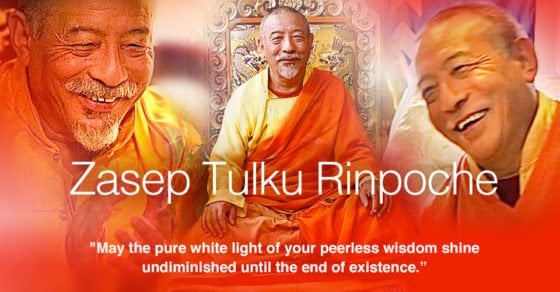
More articles by this author
Search
Latest Features
Please support the "Spread the Dharma" mission as one of our heroic Dharma Supporting Members, or with a one-time donation.
Please Help Support the “Spread the Dharma” Mission!

Be a part of the noble mission as a supporting member or a patron, or a volunteer contributor of content.
The power of Dharma to help sentient beings, in part, lies in ensuring access to Buddha’s precious Dharma — the mission of Buddha Weekly. We can’t do it without you!
A non-profit association since 2007, Buddha Weekly published many feature articles, videos, and, podcasts. Please consider supporting the mission to preserve and “Spread the Dharma." Your support as either a patron or a supporting member helps defray the high costs of producing quality Dharma content. Thank you! Learn more here, or become one of our super karma heroes on Patreon.
Venerable Zasep Rinpoche
Author | Buddha Weekly
Rinpoche is spiritual head of many Dharma Centres, and teaches around the world. Originally from Kham province in Tibet (born 1948) Rinpoche has taught in the west since 1976, after he was first invited by Geshe Thubten Loden and Lama Yeshe to teach at the Chenrezig Institute in Australia. Today, he is spiritual head of the Gaden for the West centres in Canada, U.S., and Australia and also spiritual director of the the charities Gaden Relief Project (Canada) and Manlha Tus NGO (Mongolia). He is the author of three books, including his latest release in 2018 with a rare English commentary and practice instructions for Gelug Mahamudra.

















